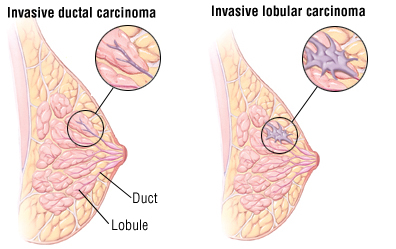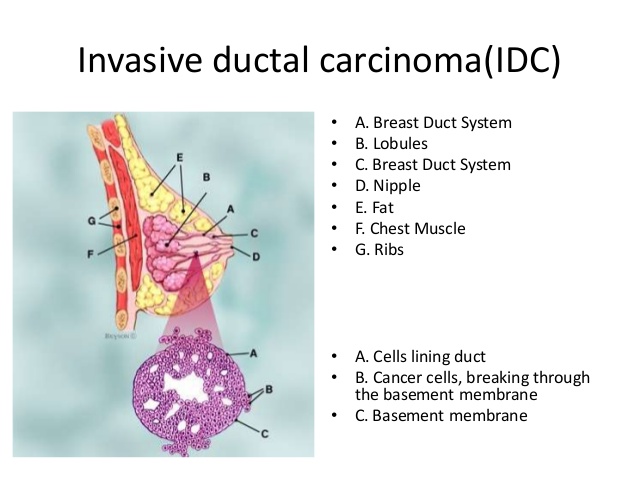The most common type of breast cancer is invasive ductal carcinoma (IDC), which is also called infiltrating ductal carcinoma. According to the American Cancer Society, 80% of all the types of breast cancers are classified as IDC. In the United States, nearly 200,000 women a year are diagnosed with it.
What Is Invasive Ductal Carcinoma?
 "Invasive" means that the cancer has spread to surrounding breast tissue and that it has invaded outside its origin. "Ductal" refers to breast cancer that starts in the milk ducts. "Carcinoma" means the cancer begins on tissue that covers an internal organ, such as breast tissue.
"Invasive" means that the cancer has spread to surrounding breast tissue and that it has invaded outside its origin. "Ductal" refers to breast cancer that starts in the milk ducts. "Carcinoma" means the cancer begins on tissue that covers an internal organ, such as breast tissue.
The combination of these three elements results in invasive ductal carcinoma – a cancer of the milk ducts that has broken through and spread to other tissues of the breast. Untreated, it can invade the lymph nodes as well as other parts of the body.
Symptoms
 In several cases of breast cancer, there are no obvious symptoms. If you have any of the following signs or symptoms, you should contact your doctor immediately for additional tests and evaluation:
In several cases of breast cancer, there are no obvious symptoms. If you have any of the following signs or symptoms, you should contact your doctor immediately for additional tests and evaluation:
- Lump or mass in breast
- Rash of the breast
- Thickening of skin on breast
- New pain in one breast
- Swelling in one breast
- Nipple pain
- Dimpling on breast or around nipple
- Redness of the breast
- Discharge from nipple
- Lump in underarm
- Abnormal changes in nipple or breast area
Diagnosis of Invasive Ductal Carcinoma
A common indication is a hard, yet movable lump felt in your breast during an examination. Sometimes it has irregular edges or can cause inverted nipple. Even if your physical exam does not reveal IDC, a mammogram may detect it. In either case, your doctor will order a biopsy to confirm the diagnosis. Because this type of cancer often spreads, your doctor will also order other tests to determine if the cancer cells have invaded other areas. Possible tests include:
- CT scan
- PET scan
- MRI
- Bone scan
- Chest x-ray
- Axillary lymph node dissection
Treatments for Invasive Ductal Carcinoma
The course of treatment will be determined by the stage and severity of your cancer based on your test results.
1. Surgery
The infected breast tissue needs to be removed, and a thorough examination is necessary to see if the cancer has spread to the lymph nodes. Your doctor will explain the different types of surgery, which include:
|
Mastectomy |
Total or simple mastectomy is when the surgeon removes the breast tissue only, leaving all the muscle tissue below the breast and all lymph nodes. |
|
Segmental mastectomy or a quadrantectomy is when a surgeon removes the portion of the breast that contains the tumor. In some cases, the surgeon may still remove lymph nodes from the armpit area. |
|
|
Modified radical mastectomy is when a surgeon removes the entire breast, the chest wall muscle lining and some of the axillary lymph nodes. |
|
|
Lumpectomy |
The surgeon only removes the tumor and some of the tissue around it. In some cases, axillary lymph nodes are removed for further examination. |
2. Radiation Therapy
After the tumor is removed, radiation therapy is used to destroy any invasive ductal carcinoma cells possibly left and to reduce the chances of the cancer coming back. High-energy rays are targeted at the breast and chest area, under the arms and around the collarbone area. Typically, radiation therapy is used in conjunction with lumpectomy or partial mastectomy surgeries. Sometimes it is used after a total or modified radical mastectomy if the tumor was over 5 centimeters and lymph nodes were affected by the cancer. Possible treatments include:
|
External beam radiation |
A linear accelerator machine delivers the radiation therapy directly to the area affected. Depending on the type of surgery, the treatment may be targeted to the entire breast area, skin and muscle and even areas containing lymph nodes. The treatment lasts up to 7 weeks, occurring once a day. |
|
Internal partial-breast irradiation |
This involves the placement of pellets made of radioactive materials directly in or near the spot of the removed tumor. Also referred to as brachytherapy, the radioactive materials are removed once the treatment is complete. |
|
External partial-breast irradiation |
An external beam of radiation is directed to the area around the cancer site, as this is the area where recurrence is most likely. This is a shorter form of radiation therapy, lasting only 5 to 10 days. |
3. Chemotherapy
During this type of treatment, anti-cancer medicines are taken by mouth in pill form and injected directly into a vein. Typically, at least two forms of chemotherapy medicines are given together. As they travel through the body via the bloodstream, they damage cancer cells and some of healthy cells, too. When the therapy hurts good cells, you may experience side effects.
When an invasive ductal carcinoma is approximately 1 centimeter and has invaded lymph nodes, chemotherapy is often given. If it's administered after surgery, it's considered adjuvant therapy. Sometimes it's administered before therapy to shrink the tumor. This is called neoadjuvant therapy. Chemotherapy is very hard on the body so it's usually given in a pattern of set treatment days followed by several days off of therapy. Treatment usually takes anywhere between 3 to 6 months.
4. Hormonal Therapy
When an invasive ductal carcinoma tests positive for hormonal receptors, treatment includes a form of hormonal therapy. Sometimes it's administered before surgery to assist in shrinking the tumor. In other cases, it follows radiation therapy or chemotherapy.
5. HER2-Targeted Therapies
When an IDC tests positive for too much protein, it is called HER2. As the cancer cells surfaces, there may also be too many HER2 receptors. When this happens, the breast cancer can quickly accelerate because it's receiving an overload of growth signals. In order to slow down the growth of the invasive ductal carcinoma cells, targeted therapies block the receptors so they don't receive the growth signals.
Follow-Up Care for Invasive Ductal Carcinoma
Follow-up is an important part in the continued treatment and monitoring of an invasive ductal carcinoma. You will work closely with your doctor to set up time for follow-up exams and regular visits for check-ups. During follow-up, you will continue to have tests done. Some of these tests and exams may include:
- Frequent physical exams – For the five years following treatment, you will have to undergo a physical exam every 4 to 6 months.
- Regular mammograms – You will have to have a mammogram of your remaining breast once a year for the rest of your life. If you are at risk of developing cancer in this breast, you may also undergo an MRI at the same time each year.
- Yearly gynecologist visits – If your post-surgery treatment includes taking tamoxifen, you will need to visit your gynecologist once a year. Unless you have had a hysterectomy, your uterus will need to be checked for abnormal cell growth. Also, you will need to report symptoms like an abnormal menstrual cycle or bleeding to your doctor for further evaluation.
- Regular bone tests – Sometimes treatment for invasive ductal carcinoma will push you into early menopause or you may have already finished it naturally. In either case, you may have to take an aromatase inhibitor as part of your treatment. If this is the case, you will need to regularly check your bone health as it can negatively affect your bones.
Additional tests or doctor visits may be necessary. You and your doctor will work together to determine what is best for you and your successful treatment.
